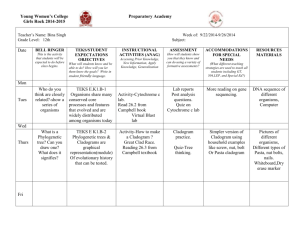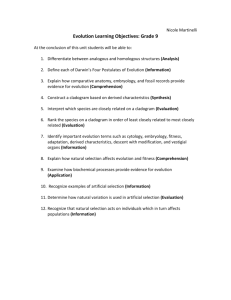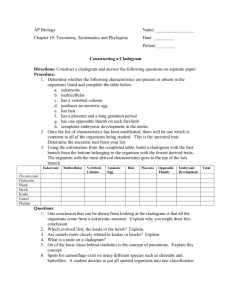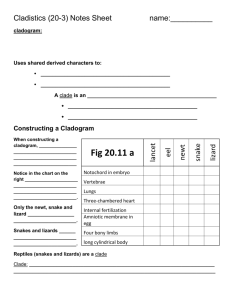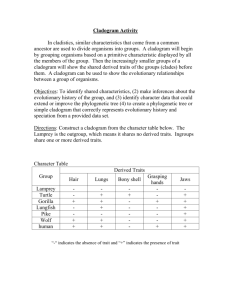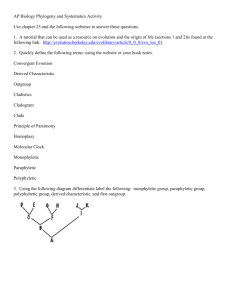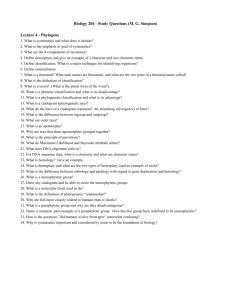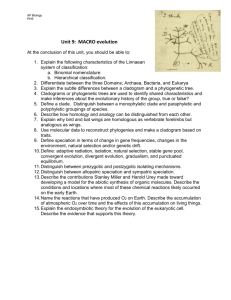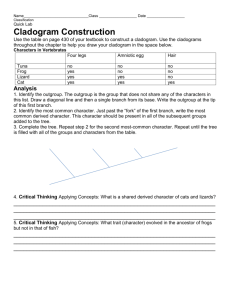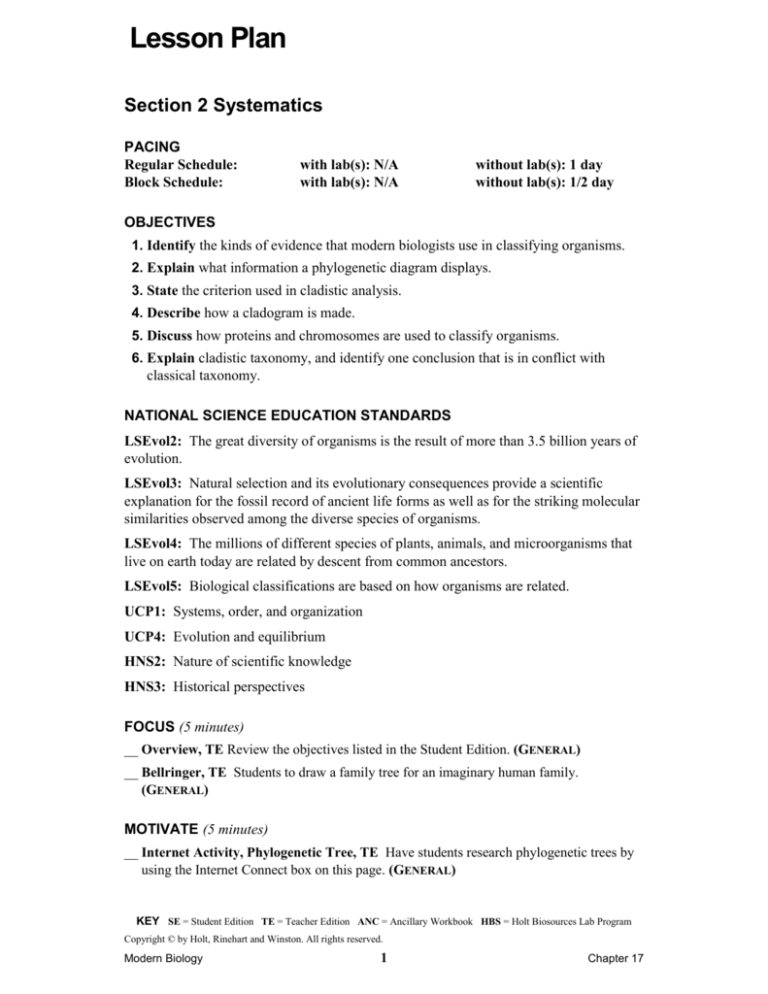
Lesson Plan
Section 2 Systematics
PACING
Regular Schedule:
Block Schedule:
with lab(s): N/A
with lab(s): N/A
without lab(s): 1 day
without lab(s): 1/2 day
OBJECTIVES
1. Identify the kinds of evidence that modern biologists use in classifying organisms.
2. Explain what information a phylogenetic diagram displays.
3. State the criterion used in cladistic analysis.
4. Describe how a cladogram is made.
5. Discuss how proteins and chromosomes are used to classify organisms.
6. Explain cladistic taxonomy, and identify one conclusion that is in conflict with
classical taxonomy.
NATIONAL SCIENCE EDUCATION STANDARDS
LSEvol2: The great diversity of organisms is the result of more than 3.5 billion years of
evolution.
LSEvol3: Natural selection and its evolutionary consequences provide a scientific
explanation for the fossil record of ancient life forms as well as for the striking molecular
similarities observed among the diverse species of organisms.
LSEvol4: The millions of different species of plants, animals, and microorganisms that
live on earth today are related by descent from common ancestors.
LSEvol5: Biological classifications are based on how organisms are related.
UCP1: Systems, order, and organization
UCP4: Evolution and equilibrium
HNS2: Nature of scientific knowledge
HNS3: Historical perspectives
FOCUS (5 minutes)
__ Overview, TE Review the objectives listed in the Student Edition. (GENERAL)
__ Bellringer, TE Students to draw a family tree for an imaginary human family.
(GENERAL)
MOTIVATE (5 minutes)
__ Internet Activity, Phylogenetic Tree, TE Have students research phylogenetic trees by
using the Internet Connect box on this page. (GENERAL)
KEY SE = Student Edition TE = Teacher Edition ANC = Ancillary Workbook HBS = Holt Biosources Lab Program
Copyright © by Holt, Rinehart and Winston. All rights reserved.
Modern Biology
1
Chapter 17
Lesson Plan
__ Reading Skill Builder, Word Origins, TE Have students look up the root meanings of
the words homologous and analogous and explain their meanings. (GENERAL)
TEACH (25 minutes)
__ PowerPoint® Resources Use the customizable presentation to help students master the
concepts in this section.
__ Skill Builder, Writing Skills, TE Students write a short essay on the difficulties of
classifying organisms. (ADVANCED)
__ Discussion, Homology Versus Analogy, TE Students are asked to determine whether the
examples given are homologous or analogous. (GENERAL)
__ Using the Figure, Clades, TE Use the diagram to point out the differences in the names
used by each system. Prompt discussion with questions about the figure. (GENERAL)
__ Using the Figure, Cladograms, TE Use the cladogram showing major plant groups to
show how a cladogram can be constructed. (GENERAL)
__ Teaching Tip, Disappearing Characteristics, TE Tell students that sometimes a
character appears in a lineage and then disappears. (GENERAL)
__ Teaching Tip, Ancestral and Derived Characters, TE Clarify when the designation of
ancestral and derived characters is useful. (ADVANCED)
__ Teaching Transparency D22, Cladogram: Mammals, Reptiles, and Birds Use this
transparency to review a cladogram of mammals, reptiles, and birds. (GENERAL)
__ Teaching Transparency, Cladogram: Major Groups of Plants Use this transparency
to review a cladogram of major plant groups. (GENERAL)
__ Using the Figure, Phylogenetic Diagrams, TE Students examine the figures comparing
amino acid sequences and the phylogenetic diagram of placental mammals. (GENERAL)
__ Discussion, Phylogenies, TE Ask: How can DNA analysis alone be used to construct a
cladogram? (GENERAL)
__ Teaching Tip, DNA Surprises, TE Point out that DNA analysis is changing some longheld beliefs about evolutionary relationships. (GENERAL)
__ Teaching Transparency D24, Similarities in Amino Acid Sequences Use this
transparency to observe similarities in amino acid sequences. (GENERAL)
__ Teaching Transparency D25, Phylogenetic Diagram of Mammals Use this
transparency to show a phlyogenetic diagram of mammals. (GENERAL)
CLOSE (10 minutes)
__ Section Review, SE Students are assessed through questions about key concepts and
questions that require critical thinking skills. (GENERAL)
__ Reteaching, Recognizing Clades, TE Lead students to look for other phylogenetic
diagrams in future chapters of the book and the appendix. (BASIC)
__ Quiz, TE Students answer short answer questions about this section. (GENERAL)
KEY SE = Student Edition TE = Teacher Edition ANC = Ancillary Workbook HBS = Holt Biosources Lab Program
Copyright © by Holt, Rinehart and Winston. All rights reserved.
Modern Biology
2
Chapter 17
Lesson Plan
OTHER RESOURCE OPTIONS
__ Active Reading Worksheets, ANC Students are asked to analyze a passage related to the
chapter text and answer questions about the passage. (BASIC)
__ Quick, Data, and Math Labs, Using a Field Guide, HBS Students learn to use a field
guide. (BASIC)
__ Quick, Data, and Math Labs, Making a Cladogram, HBS Students use given data to
construct a cladogram. (BASIC)
__ Visual Concepts CD-ROM Use this multimedia resource to reinforce selected concepts
from the chapter.
KEY SE = Student Edition TE = Teacher Edition ANC = Ancillary Workbook HBS = Holt Biosources Lab Program
Copyright © by Holt, Rinehart and Winston. All rights reserved.
Modern Biology
3
Chapter 17

